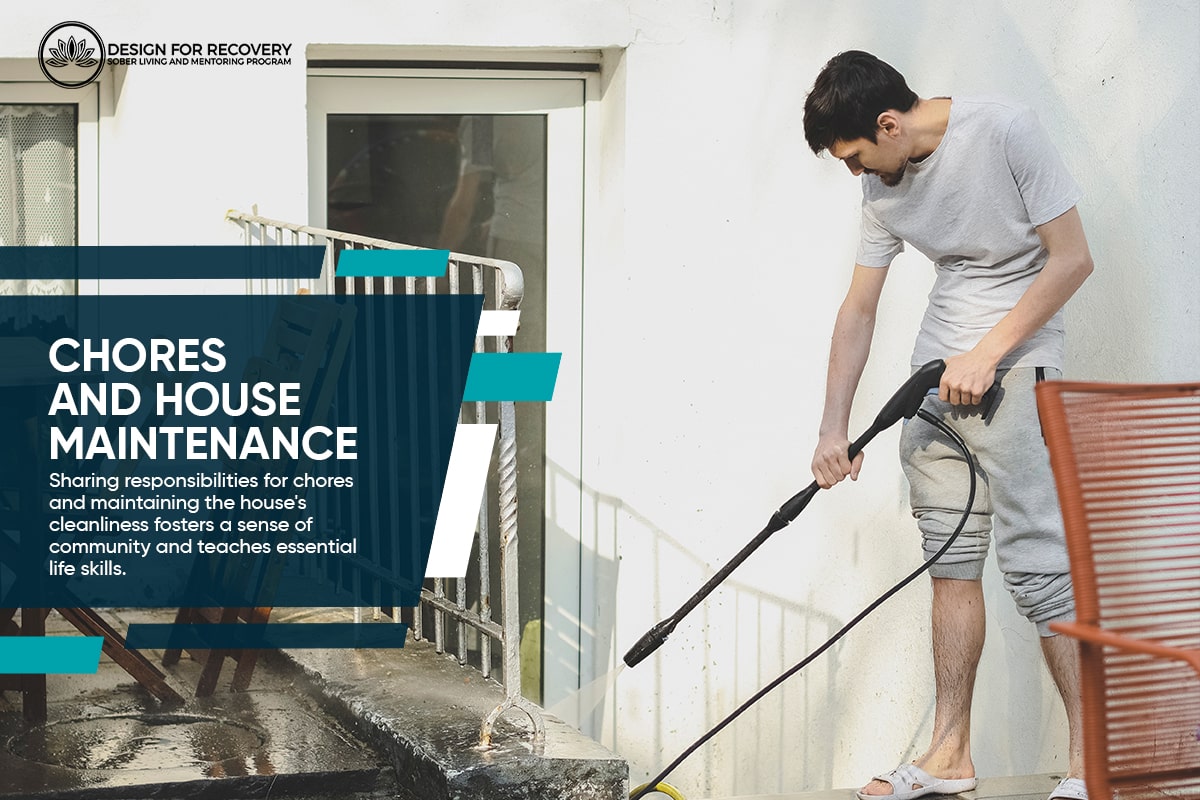Recovery from substance abuse isn’t easy, especially for young adults. It’s a road with ups and downs, requiring courage, determination, and help. One vital form of support on this journey is “sober living.” But what’s that, and how can it help young adults recover?
Sober living, in simple terms, is a type of shared housing where individuals in the recovery process live together in a supportive and substance-free environment. It’s like a stepping stone that helps people transition from the more structured environment of drug and alcohol addiction treatment programs to the real world.
In sober living houses, rules and expectations are in place to ensure residents stay sober, like regular drug testing and attendance at support group meetings. Sober living houses offer a safe and structured space where you can practice what you’ve learned in treatment, like coping strategies and staying sober, but with a safety net.
Sober Living House Rules for Young Adults
Entering a sober house is a significant step on the path to recovery, and it comes with specific requirements and rules designed to provide structure, support, and, above all, a safe and substance-free environment.
Let’s dive into what these typical sober living house rules and guidelines entail and how they play a crucial role in maintaining a secure and supportive atmosphere for recovering addicts:
Abstinence: The cornerstone of sober living is abstinence from drugs and alcohol. Residents are expected to remain entirely substance-free during their stay.
Regular Drug Testing: Many sober living homes conduct regular drug and alcohol testing to ensure compliance with abstinence. This not only helps residents stay accountable but also maintains a drug-free environment.

Participation in Support Groups: Residents are often required to attend meetings of support groups, such as Alcoholics Anonymous or Narcotics Anonymous, to receive ongoing support and connect with peers on a similar journey.
Curfew and Accountability: Sober living houses typically have a curfew in place to ensure residents are safe and not engaging in risky behaviors. Accountability measures like check-ins and regular meetings with house managers help enforce curfew and maintain accountability.
Financial Responsibility: Residents are responsible for paying rent and other expenses promptly. This teaches financial responsibility and ensures the smooth functioning of the house.
Chores and House Maintenance: Sharing responsibilities for tasks and maintaining the house’s cleanliness fosters community and teaches essential life skills.

No Violence or Harassment: A strict policy against violence, harassment, or aggressive behavior is enforced to maintain a safe and respectful living environment.
These guidelines maintain a safe and substance-free environment, including accountability, community Support, structure and routine, financial responsibility, and a safe environment.
In essence, these rules are not restrictive but empowering. They create a supportive framework that empowers young adults in the recovery program to build a strong foundation for a substance-free and fulfilling life.
Benefits of Sober Living Homes for Young Adults
Sober living homes offer young adults in recovery a unique opportunity to transform their lives. Here are some positive outcomes observed among residents:
Residents experience increased periods of sobriety due to the supportive environment and accountability measures in place.
A structured environment teaches essential life skills, such as financial responsibility and time management.
Building connections with peers in similar situations fosters a robust support network beyond sober living.

Residents often report reduced anxiety and depression symptoms as they focus on recovery and self-improvement.
The recovery journey leads to personal growth, self-discovery, and increased self-esteem.
Residents gain confidence in their ability to maintain sobriety and lead healthier lives.
The positive outcomes, such as a healthy lifestyle, strong support network, and improved mental health, reflect personal growth. Residents better understand themselves and their capabilities, increasing self-esteem and confidence.
Also, increased periods of sobriety and reduced anxiety and depression symptoms are clear indicators of effective sobriety maintenance. Living in a supportive environment and building connections with peers help residents stay on track in their recovery journey.
Sober Facilities for Extended Stays
Sober living homes are acutely aware that recovery is a journey that doesn’t follow a strict timetable. Young adults in recovery often need extended stay options, and these homes cater to this need by providing a nurturing environment that supports ongoing growth and healing.
Sober living homes offer flexible lengths of stay, recognizing that everyone’s recovery journey is unique. This flexibility allows residents to determine the duration of their stay based on their progress and personal needs.
Rather than imposing rigid timelines, these homes encourage residents to transition to independent living when they feel confident and ready. This approach fosters a sense of empowerment, ensuring that residents are well-prepared for the challenges.
The facilities and amenities typically offered to support residents’ well-being include the following:
Peer Support
Regular Drug Testing
Support Group Participation
Life Skills Training
Mental Health Support
Recreational Activities
How Sober Living Works for Young Adults
Sober living homes offer a structured and supportive environment tailored to the unique needs of young adults in recovery. Here’s how the structure of sober living homes and elements like peer support, accountability, and life skills development contribute to their successful recovery journey:
Daily Routine: Sober living homes provide a structured everyday life, including curfews and house meetings, which help residents develop healthy habits and stability.
Safe Environment: Residents live in a substance-free environment where the risk of relapse is minimized, offering them a safe space to focus on their recovery.
Transitional Phase: Sober living bridges treatment programs and independent living, gradually allowing young adults to transition into society while receiving continued support.
Flexible Stay: The flexibility of sober living allows residents to determine the duration of their stay based on their progress, ensuring they don’t feel rushed in their recovery.
In the dynamic environment of sober living homes, peer support plays a pivotal role as residents share similar experiences, fostering a strong sense of community. Also, accountability mechanisms, such as regular drug testing and enforced curfews, are firmly in place, ensuring residents remain committed to sobriety.
Lastly, life skills development programs are integral to sober living homes. These initiatives empower young adults by equipping them with essential life skills such as budgeting, job hunting, and time management.
What to Expect in a Sober Living Home?
In terms of the living environment of a sober living home, residents can anticipate a structured and supportive space. These homes offer a safe and substance-free setting where those living in a sober house can focus on their journey to sobriety without the temptations of drugs or alcohol.
The Sober House Manager serves as a vital link between staff and residents, aiding residents in setting and attaining their goals and addressing their requirements. Additionally, they lead weekly client house meetings, facilitating discussions on internal issues, reviewing house rules, assisting with requests for medical appointments, and overseeing scheduling for the upcoming week. This active role ensures the effective functioning of the sober living environment.
The daily routine in a sober living home is designed to instill a sense of stability and responsibility. Residents in a recovery program often adhere to curfews, attend house meetings, and follow a structured schedule.
In terms of daily activities, sober living homes encourage engagement in support group meetings, such as Alcoholics Anonymous or Narcotics Anonymous, which foster personal growth and connection with others on a similar path. Residents may also participate in life skills development programs, aiding their transition to independent living.
How to Choose the Right Time to Move into Sober Living?
Determining the optimal time for a young adult to transition into a sober living home depends on various factors. It’s essential to consider:
Stability in Early Recovery: It’s advisable to move into sober living when an individual has achieved a certain level of stability in early recovery, including abstinence and commitment to sobriety.
Completion of Treatment: Many choose to enter sober living after completing an initial treatment program to ensure a smoother transition and ongoing support.
Personal Readiness: The young adult’s readiness and willingness to embrace the structure and support offered in a sober living environment are critical factors.
External Support: Assessing the availability of external support from family and friends can also influence the decision.
Choosing the right time to move into a sober living home involves evaluating these factors to ensure a successful and supportive transition to lasting recovery.
What are the different Types of Sober Living Houses?
Several types of sober living houses, including halfway houses, are available for young adults, each catering to specific needs and preferences:
Gender-Specific Homes: These homes are separated by gender for added comfort and focus, particularly for individuals with substance use disorders.
Age-Specific Residences: Tailored to specific age groups, these residences create relatable peer groups, fostering a sense of camaraderie, especially for those facing substance use disorders.
Specialized Recovery Focus: Some sober living homes target specific addiction types, like alcohol or drugs, ensuring residents with substance use disorders receive tailored support.
Transitional Living: These residences support individuals, including those with substance use disorders, in transitioning to independent living, offering a gradual shift towards self-sufficiency.
These variations cater to specific needs, preferences, and stages of recovery, allowing individuals, including those with substance use disorders, to find the right fit for their unique circumstances and enhancing their chances of successful recovery.
The History and Evolution of Sober Living Houses
Sober living houses trace their origins to the mid-20th century when the concept emerged as a supportive environment for individuals navigating addiction recovery. Initially, these homes provided a bridge between structured treatment programs and independent living, offering residents a place to transition at their own pace.
Over time, sober living houses evolved to encompass various residences, each catering to specific needs and preferences. This evolution recognizes individuals’ diverse challenges during recovery, from gender-specific homes to age-tailored residences and specialized recovery-focused options.
The growth of sober living houses was influenced by historical contexts such as the civil rights movement and the shifting perception of addiction as a treatable condition instead of a moral failing. These factors contributed to developing a more compassionate and supportive approach to addiction recovery, underscoring the importance of sober living houses in the continuum of care.
Examples and Cases Demonstrating the Need for Sober Living for Young Adults
Jake’s Journey to Recovery: Jake, a young adult struggling with alcohol addiction, completed a residential treatment program but faced the challenge of returning to his old environment, which was filled with triggers. Sober Living provided Jake with a safe and supportive space to continue his recovery journey, ultimately helping him transition to independent living successfully.
Sarah’s Fresh Start: In her early twenties, Sarah battled opioid addiction. After completing detox and rehab, she realized that returning home immediately could jeopardize her progress. Sober living houses offered Sarah an extended support system, enabling her to regain her independence while staying on track with her recovery.
These real-life examples underscore the vital role that sober living plays in supporting young adults in recovery. It offers a safe and structured environment where individuals can continue their journey towards lasting sobriety, free from the triggers and influences that may have contributed to their addiction in the first place, while addressing any misconceptions about problems with sober living homes.
How to Pay for Your Stay at a Sober Living Home?
Young adults can effectively manage the financial aspect of staying in a sober living home through the following steps:
Personal Savings: Utilize personal savings or resources to cover sober living costs.
Insurance: Explore if health insurance policies cover sober living expenses.
Family Support: Seek assistance from family members willing to contribute financially.
Scholarships and Grants: Research available scholarships or grants specifically designed to support recovery housing.
Part-Time Work: Consider part-time employment to help offset the expenses while maintaining focus on recovery.
These options empower young adults to access quality care at sober living homes and navigate the financial aspects effectively.
Duration of Stay in a Sober Living Home
Young adults’ stay in sober living homes can vary widely, with several factors influencing the duration:
Individual Progress: The length of stay often depends on an individual’s progress in recovery. Some may benefit from a few months, while others may choose a longer stay.
Treatment History: Those with a history of relapse or more extended addiction may opt for a more extended stay to solidify their recovery.
Personal Goals: Young adults set their goals for recovery, which can influence the duration. Some may aim for a more extended period to build a stronger foundation.
External Support: Consideration should be given to external support systems, such as family and friends, to determine when independent living is feasible.
Considering these factors is crucial when planning how long you should stay in a sober living home. The goal is to strike the right balance that ensures a successful transition to independent living while maintaining a strong foundation in recovery.
Finding the Help You Need
Sobriety promises a brighter future, but navigating this path can be daunting, especially for young adults. Fortunately, sober living homes offer a beacon of hope, providing a supportive environment where individuals can continue their recovery journey.
At Design For Recovery, we specialize in offering daily support on the lifelong path to recovery within our Southern California sober living communities. Our structured sober living homes have earned a reputation for transforming the lives of men struggling with substance abuse, mental health issues, and impulse control disorders.
If you’re ready to take the next step towards a brighter, substance-free future, don’t hesitate to contact us. We’re here to help you find the daily support and hope you need to reclaim your life from the grasp of addiction.
Frequently Asked Questions
What Is Sober Living, and How Does It Differ From Traditional Rehab Programs?
Sober living provides a supportive, substance-free environment where individuals in recovery can gradually transition to independent life, contrasting with traditional rehab programs offering intensive, structured treatment.
What are the Benefits of Choosing a Gender-Specific Sober Living Home for Young Adults?
Gender-specific sober living homes create a more comfortable and focused atmosphere by separating residents by gender, promoting a sense of camaraderie, and reducing distractions.
How Can Peer Support in Sober Living Homes Aid Young Adults in Their Recovery Journey?
Peer support in sober living homes fosters a strong sense of community, offering mutual encouragement, understanding, and reduced feelings of isolation during the recovery journey.
What Financial Options are Available to Help Cover the Costs of Sober Living for Young Adults?
Young adults can utilize personal savings, insurance coverage, family support, scholarships, grants, or part-time employment to cover the costs of their stay in a sober living home.
Sources
Polcin, D. L., Korcha, R. A., Bond, J., & Galloway, G. (2010). Sober living houses for alcohol and drug dependence: 18-month outcomes.Journal of substance abuse treatment, 38(4), 356–365. https://doi.org/10.1016/j.jsat.2010.02.003
Mericle, A. A., Mahoney, E., Korcha, R., Delucchi, K., & Polcin, D. L. (2019). Sober living house characteristics: A multilevel analyses of factors associated with improved outcomes.Journal of substance abuse treatment, 98, 28–38. https://doi.org/10.1016/j.jsat.2018.12.004
Polcin, D. L., Korcha, R., Bond, J., & Galloway, G. (2010). What did we learn from our study on sober living houses and where do we go from here?.Journal of psychoactive drugs, 42(4), 425–433. https://doi.org/10.1080/02791072.2010.10400705
mental illness








